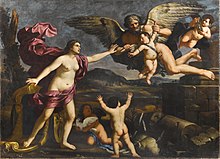Giacinto Gimignani
Giacinto Gimignani (baptized January 23, 1606 in Pistoia , † December 9, 1681 in Rome ) was an Italian painter and printmaker .
Life
Giacinto Gimignani was born in early 1606 as the son of the painter Alessio Gimignani and Dianora Tognelli. From childhood, Gimignani was trained in his father's workshop. Presumably he was involved in his commissions in the churches of his hometown Pistoia early on. From 1630 at the latest, Gimignani was active in Rome. In 1632 he worked in the Palazzo Barberini . For Cardinal Francesco Barberini he also painted in 1632 the “Willow my lambs” for the Church of San Pietro in Castel San Pietro Romano .
Due to the close proximity to the style of Pietro da Cortona , it is assumed that Gimignani worked in Cortona's workshop during the first years in Rome. Later Gimignani turned more to Nicolas Poussin's classicist baroque . In 1634 at the latest he was a member of the Accademia di San Luca . From 1637 the painter had close contact with northern Alpine artists.
On November 18, 1640, Gimignani married, meanwhile with numerous commissions from high-ranking members of the Urbans VIII Curia , in the Roman church of San Lorenzo in Lucina Cecilia Turchi († 1667), the daughter of the painter Alessandro Turchi . In 1640 he moved into his own house with her in Via Felice in Rome, which, apart from his stay in Florence, he lived in until his death. The couple had eight children, including the painter Ludovico Gimignani . The daughters and son Alessio later joined the Benedictine order .
The 1640s were characterized by intensive artistic activity, which was accompanied by a stylistic approach to Andrea Sacchi and her father-in-law. In the Baptistery of the Lateran Gimignani worked under the artistic direction of Sacchi and painted one of the five wall frescoes ("Constantine Vision") alongside Andrea Camassei , Carlo Maratti and Carlo Magnone . From 1647 Gimignani also worked as a copperplate engraver and created, among other things, illustrations for the second volume of Famiano Stradas De Bello Belgico .
In 1652 the family moved to Florence and Gimignani began working for the Medici court . Commissioned by Grand Duke Ferdinand II , the cardboard for the fresco The Coronation of Giovanna d'Austria on her arrival in Florence at Porta al Prato was created in 1654 . Between 1652 and 1654 a series of 25 paintings was created for the Rospigliosi in Pistoia with religious and mythological subjects, as well as a series of 12 paintings with allegorical and mythological subjects for Principe Mattias de'Medici . Gimignani quickly found admirers here too and was able to produce numerous commissioned works. In 1661 he returned to Rome and began working with his son Ludovico. His color palette brightened increasingly during this time. Allegorical and mythological contents, which he often varied in large numbers, became the preferred subject. The late work is characterized by a strict, classic simplicity of the Bolognese style.
literature
- Odoardo Hillyer Giglioli: Gimignani, Giacinto. In: Enciclopedia-Italiana. treccani.it, 1933, accessed March 6, 2019 . (different year of birth 1611, out of date).
- Bernd Curt Kreplin : Gimignani (Gemignani, Geminiani), Giacinto . In: Ulrich Thieme , Fred. C. Willis (Ed.): General lexicon of visual artists from antiquity to the present . Founded by Ulrich Thieme and Felix Becker . tape 14 : Giddens-Gress . EA Seemann, Leipzig 1921, p. 57–58 ( Textarchiv - Internet Archive ). - (different year of birth 1611, out of date).
- Ursula Verena Fischer: Giacinto Gimignani (1606–1681). A study of the Roman painting of the Seicento. Dissertation at the Albert Ludwig University, Freiburg im Breisgau 1973.
- Ursula Verena Fischer-Pace: Les Oeuvres de Giacinto Gimignani dans les collections publiques françaises. In: Revue du Louvre 28, 1978, pp. 343-358.
- Angela Negro: Gimignani, Giacinto. In: Mario Caravale (ed.): Dizionario Biografico degli Italiani (DBI). Volume 54: Ghiselli-Gimma. Istituto della Enciclopedia Italiana, Rome 2000.
Web links
Individual evidence
- ↑ Angela Negro: Gimignani, Giacinto. In: Mario Caravale (ed.): Dizionario Biografico degli Italiani (DBI). Volume 54: Ghiselli-Gimma. Istituto della Enciclopedia Italiana, Rome 2000.
| personal data | |
|---|---|
| SURNAME | Gimignani, Giacinto |
| BRIEF DESCRIPTION | High baroque painter |
| DATE OF BIRTH | baptized January 23, 1606 |
| PLACE OF BIRTH | Pistoia |
| DATE OF DEATH | December 9, 1681 |
| Place of death | Rome |

